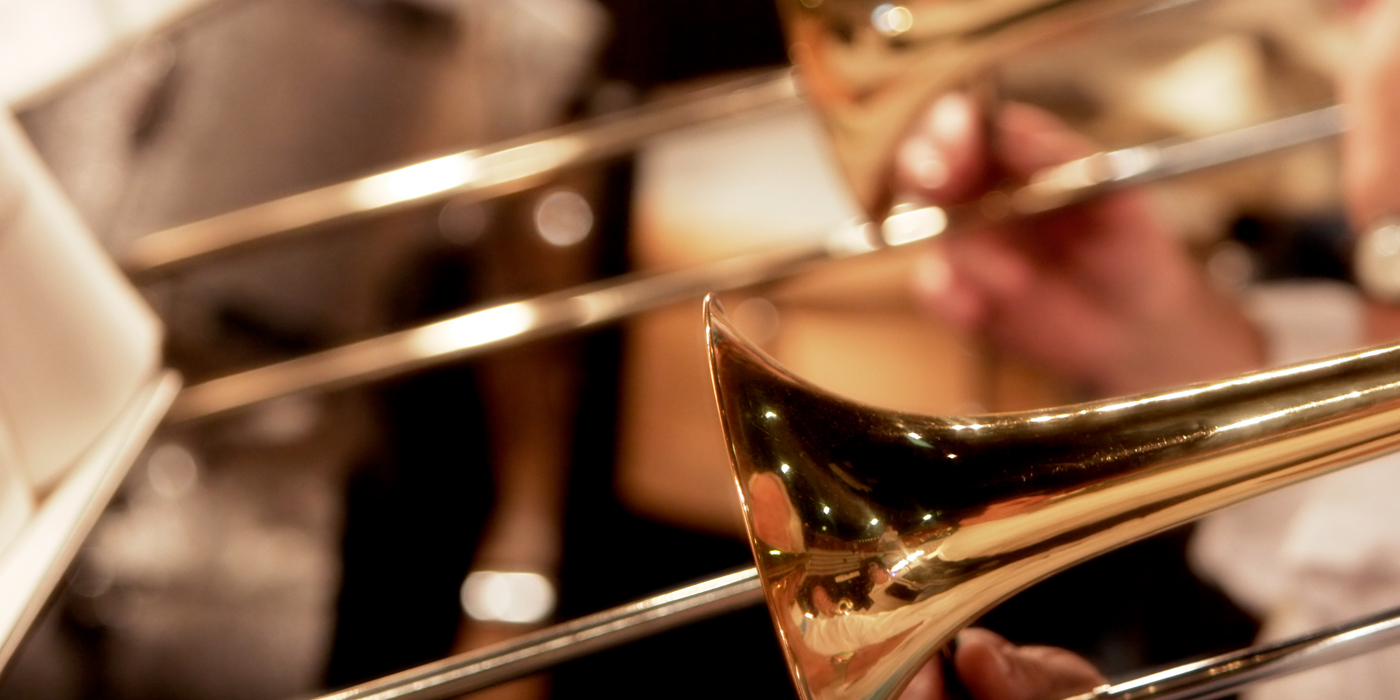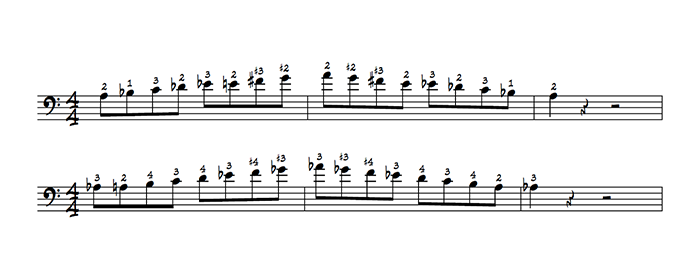
Having a strong trombone section can take your big band to the next level. It’s tempting to focus on the shout chorus and the sax soli and leave the trombones to their own devices, but a few simple adjustments can bring your young jazz trombonists up a notch, and add power, balance, and consistency to your horn section.
Here are five quick fixes you can make to improve the trombone section in your jazz band.
Alternate Positions
The most important thing about alternate positions is to use them. Often, alternate positions are the key to navigating tricky bebop or soli lines that would otherwise border on impossible. Of course, use good slide technique (very little wrist, minimal pressure, only the thumb and one or two fingers on the brace, etc.) but alternate positions go a long way.
Playing more advanced scales provides an excellent opportunity to work with alternate positions. The octatonic scale works well for this. In the example below, the first octatonic scale doesn’t require large slide movements or awkward direction changes. Translating those movements out a position (to move the scale down a half step) maintains the simple slide motions by accessing alternate positions. The second scale would be more difficult if we played Ds and Fs in first position, rather than their alternates.

Be sure to encourage your students to swing the scale – that’s how you get comfortable using it in a solo! Notice that by using alternate positions we also get to take advantage of many natural slurs. This scale can be worked up to pretty extreme tempos without much difficulty. This is because you only need to tongue every other note and the positions stay close together.
A word of warning about alternate positions: as with any instrument, alternate fingerings have different tuning tendencies. In many cases on trombone, alternate positions have opposite tuning tendencies from the typical position. For example, F3 is sharp in first position and must be lowered, but F3 in fourth position is so extremely flat that it’s basically in third-and-a-half position.
Ghost Notes
Ghosting notes is a crucial aspect of playing bebop correctly. It’s also important in swing, but to a lesser extent. Sometimes ghosting is described as “swallowing” the note. However, for trombonists, no swallowing is required – the term doesn’t match what actually happens with the mouth. Instead, it’s more of a note that doesn’t quite speak. This gets easier when the ghosted note is on a different partial than the notes that need accents (and when the line is idiomatic).
Here’s an example:
In the first measure, ghosting the note is simple; the position doesn’t change. But in the second measure of this example, ghosting the note eliminates the need to make an awkward direction change with the slide. Simply false tone an Eb rather than worry about getting the slide all the way in for the F that doesn’t really exist.
By introducing the ghosted notes in a swinging environment and using lip slurs to show that the notes don’t need to speak normally, but aren’t necessarily “swallowed,” young trombonists will learn more quickly.
Tone Production
The simple fix here is not to fix anything at all.
Good brass tone is good brass tone, and it doesn’t matter if you’re playing Gordon Goodwin or Percy Grainger. I think it’s a common misconception that young brass players need to fix or change their embouchure, air support, or general tone color between concert band and jazz band. While more advanced players (who can access more potential tone colors without sacrificing technique) may strive for more edge in a big band, it’s not necessary for young trombonists to do this in order to be stylistically appropriate.
Indeed, famous jazz trombonists from many eras have deliberately accessed darker, more orchestral tone colors, including Curtis Fuller and Bill Watrous. Jazz style, including the loud, edgy hits common to big band trombone writing, comes from articulation far more than it comes from a change in sound.
Vibrato
Slide vibrato is a very intuitive motion that’s difficult to perform correctly. Students will eagerly start whipping their slide back and forth, blissfully unaware that they sound like Tommy Dorsey having a mariachi nightmare. The most important thing to remember with slide vibrato is style. Both you and your students should listen to reference recordings to figure out what kind of vibrato the piece calls for. Specifically, listen for the following:
- Speed. Is this rhythmic pulsing or more random?
- Width. How far away from the pitch center does the vibrato get?
- Players. Lead player only or whole section?
If your students aren’t getting the slide vibrato you want, the Army Jazz Ambassadors have a great technique video that covers the basics:
Equipment
Trombones are bigger than they were 100 years ago. American orchestras led much of this trend. Today, even the student model trombones that we see in beginning band are significantly larger than the horns commonly used by swing-era big bands, and most jazz tenor trombonists today use smaller equipment than their orchestral counterparts.
Should students intentionally use smaller equipment for jazz band? For the student whose parents recently invested in a large bore, orchestral trombone, it can be a tough question. As a private teacher and former jazz band director, I say no. Many jazzers (myself included) use smaller equipment because it enables firmer attacks and smoothness of playing in the extreme high register. These are nuances that may or may not affect the younger player; however, the real risk is that a student uses an inferior instrument just because it’s smaller and therefore a “jazz horn.” The benefits that come with using a higher-quality instrument outweigh the downsides to using larger equipment.
The same principles apply to mouthpieces. If a student has high-quality equipment that’s smaller, feel free to have them use it. Young students rarely have multiple instruments, so in general, I have them play the better-made, larger equipment in big band. Again, there are great examples of jazz trombonists using large-bore equipment, like Robin Eubanks.
I hope these quick fixes help you get your young jazz trombonists off to a great start in big band!